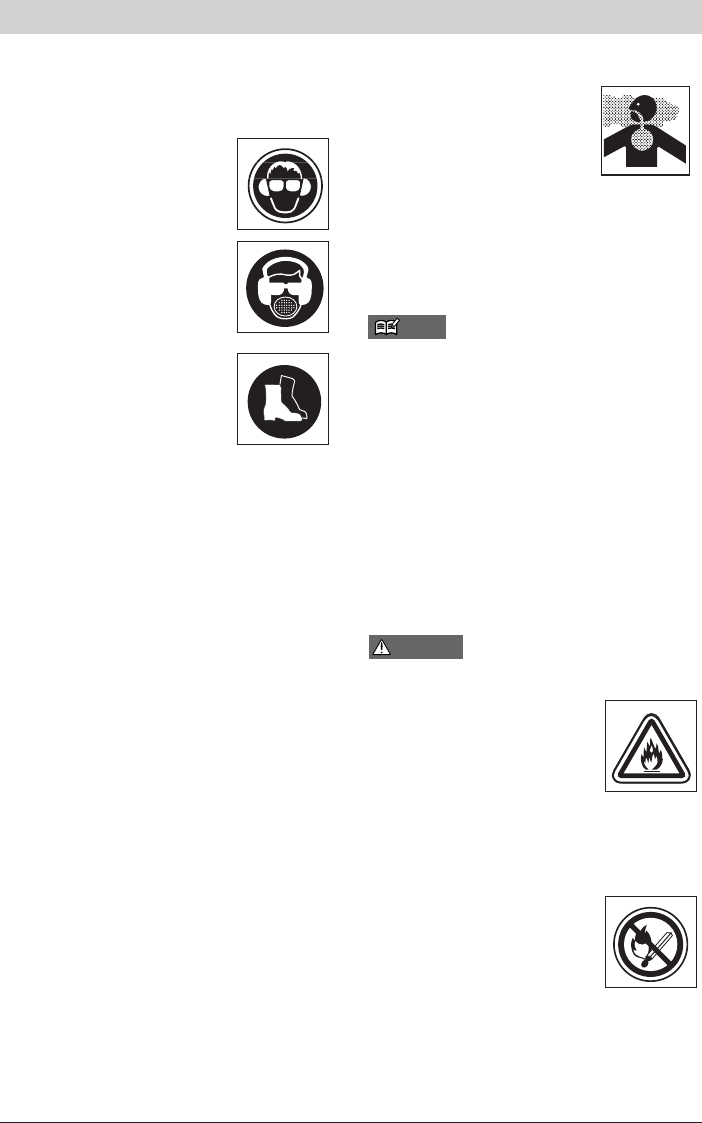
English
6
1. Refrain from operating the blower if you are tired, ill,
or upset, or if you are under the influence of alcohol,
drugs or medication
2. To reduce the risk of hearing loss associated with
sound levels, hearing protection is
required.
3. To reduce the risk of injury
associated with thrown objects,
always wear eye protection and
foot protection. Approved protective
goggles must comply with standard
ANSI Z87.1 in the USA or EN 166
in EU countries.
4. To reduce the risk of injury
associated with the inhalation of
dust, use a face filter mask in dusty
conditions.
5. Wear rubber-soled shoes or shoes
with some other form of anti-slip
protection to help protect you
against falling.
6. To reduce the risk of injury
associated with objects being
drawn into rotating parts, do not
wear loose clothing, scarves, neck
chains, hair longer than shoulder
length, or other loose material.
7. Prolonged use of a blower, exposing the operator to
vibrations and cold, may produce whitefinger
disease (Raynaud’s phenomenon), the symptoms of
which include tingling and burning sensations
followed by loss of color and numbness in the
fingers. All factors which contribute to whitefinger
disease are not known, but cold weather, smoking
diseases or physical conditions as well as long
periods of exposure to vibration are mentioned as
factors. In order to reduce the risk of whitefinger
disease, the following precautions are strongly
recommended
a) Keep your body warm. Never use the blower
during rain.
b) Take more than 5 minutes of break in a warm
place frequently.
c) Maintain a firm grip at all times, but do not
squeeze the handles with constant, excessive
pressure.
d) If you feel discomfort, redness and swelling of
your fingers or any other part of your body, see
a doctor before it gets worse.
8. The ignition system of your unit produces an
electromagnetic field of a very low intensity. This field
may interfere with some pacemakers. To reduce the
risk of serious or fatal injury, people with pacemaker
should consult their physician and the pacemaker
manufacturer before operating this tool.
WORKING CIRCUMSTANCE
1. To reduce the risk of injury
associated with exhaust fume
inhalation, do not operate in
unventilated area. The exhaust
gases contain harmful carbon
monoxide.
2. Avoid using the blower where
stable footing and balance are
not assured.
3. Never operate the machine in high wind, bad
weather, potentially explosive atmosphere, when
visibility is poor or in very high or low temperatures.
(Our recommended use environment is below 40
degrees C (104 degrees F).)
AVOID NOISE PROBLEM
NOTE
Check and follow the local regulations as to
sound levels and hours of operations for blower.
1. Operate power equipment only at reasonable hours,
not early in the morning or late at night when people
might be disturbed. Comply with times listed in local
ordinances.
2. To reduce sound levels, limit the number of pieces of
equipment used at any one time.
3. Operate power blowers at the lowest possible throttle
speed to do the job.
4. Check your equipment before operation, especially
the muffler, air intakes and air filters.
WORKING PLAN
To reduce the risk of health damages, avoid excessive
use and take sufficient time to rest .
FUEL
WARNING
To reduce the risk of fire and burn injury:
a) Handle fuel with care. It is highly
flammable.
b) Do not smoke while handing fuel.
c) Do not refuel a hot engine.
d) Do not refuel a running engine.
e) Avoid spilling fuel or oil. Always
wipe unit dry before using.
f) Move at least 10 ft. (3 meters)
away from the fueling point before starting the
engine.
g) Always store gasoline in a container approved for
flammable liquids.
h) Make sure the unit is properly assembled and in
good operating condition.
i) Do not use the blower near a fire,
as aiming the blower in the
direction of a flame may cause
flammable substances to ignite.
Safety Precautions
H1153190-95US.fm Page 6 Tuesday, December 15, 2009 9:05 AM


















